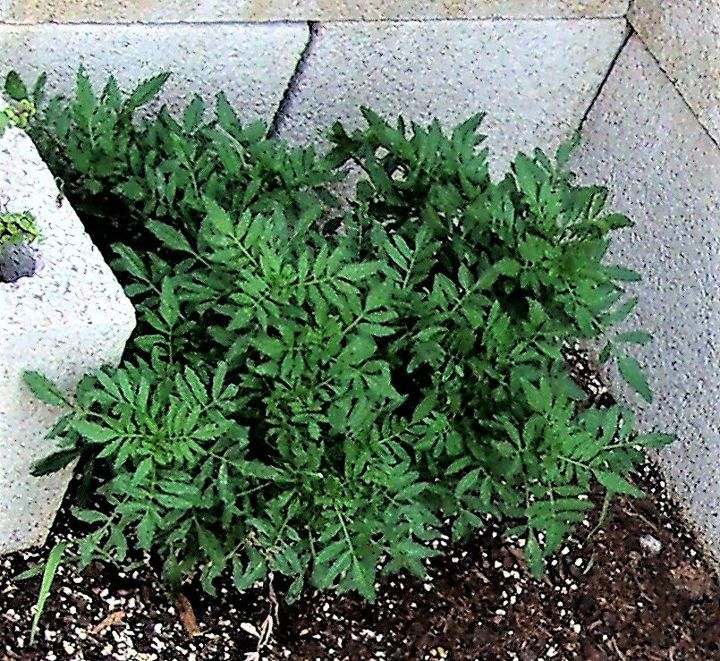How do I get rid of ferns that keep coming back up?
I dig, pull up roots every year but they always come back in the same spot crowding out my other plants
Related Discussions
GNATS - How to get rid of them?
Somehow my house and garden got tiny gnats that killed my fuchsia plant and fly everywhere. I have tried ALL the Web recommendations - soap and oil dishes, sand in th... See more
Marigolds growing! Should I pinch the buds?
My marigold plants are growing. I heard that pinching the buds until Autumn will allow them to grow without killing the plant. Is this true?
Growing garlic
Growing our first garlic, should we wait until the leaves are drying out before we pick it? Husband picked first one today along with our first potatoes.
How to keep mice out of your garden?
Hi everyone, I have mice in my garden destroying my vegetables and I have also noticed them in the barn and shed. Please can someone tell me how to prevent them from ... See more
What's the best flower/plant to grow in Texas?
I know that opinions vary, but what's your opinion?!I have great luck w Rosemary plants. Green all year long.
How can I get rid of "spring onions" growing throughout yard, lambs ear that keeps coming back, even though the pesty
things have been completely dug up for two years now? Also, a spidery type weed, with little green leave and a tiny light blue flower? It all started out in one tiny ... See more
How do I kill flowers that keep coming back every year ,that spread li
Im pretty sure they are all so called pink blossoms,I had bought from Spring Nursery.



Call your state’s extension office. Those guys are a wealth of knowledge!
I have a similar situation although over time I let the ferns grow and adapted to "them" for a more naturalized look. Ferns have a tunneling root system which means that they just keep spreading out and spreading out under the ground. I invited the neighbors to come over for free ferns! My aim was to get as much out of the underground as possible. The clearing worked for a while but after a few years they started coming back choking out my other perennial ground cover SO I just went with it. I planted all kinds of perennial bulbs that could survive among the ferns. The result is actually breathtaking. I live in a zone 4-5. We have long summers and hard winters. I hope I've helped in some way. Best of luck
Hi. The problem is they have small tubers that easily come off when pulling them up. You'll need to dig down about a foot and remove the soil. That's the only way to get rid of them.
Plants are not decorations.
They have adapted themselves to specific locations based on type of soil, access to water, protection from cold, sun exposure and other factors. Their roots grow to reach the water source underground. In areas of the country which are prone to drought, native prairie plants and grasses reach down as far as 20 feet so that can survive when there is no rain. Those roots hold the soil from washing or blowing away. In areas with lots of rain or shallow soil, root systems spread out sideways and link with other roots to form a web to hold the soil.
In the case of plants in your area, they may also be salt tolerant and hurricane resistant, which is something to consider with climate change, and rising sea level. The ferns and mangrove forests along the coast are the bulwarks to protect the coastlines from erosion. The grasses of the Everglades once acted as a great protective filter for the water flowing south through Florida, and are in the process of being restored..
As open land is developed and houses and pavement are put in place, rainwater cannot get into the ground where it is needed, or it is funneled through pipes and drains into our streams and rivers. This often leads to flooding downstream.
Native plants have adapted along with native birds and pollinators, providing food and shelter and nesting materials, to make sure every species survives. People moving from one region of the country to another may sometimes long for the plants they are used to. Though those plants may be commercially available, they are not necessarily helpful to the new environment, as they are not compatible with the local birds and pollinators. Often, the gardener has to spend lots of time and money to get these plants to grow in the new place, while the garden does not contribute much to Nature.
There is a movement of gardeners across the country who are learning about the plants native to their areas. If you will consider adapting your garden plans to incorporate the native which are already there, you will be helping all the species, and your garden will be full of Life!
The Florida Native Plant Society has a website which you may find helpful.
Be well!
I don't know what type of fern you're dealing with but I noticed when I pulled tall native Oregon ferns they immediately shot up new stems. I learned to adapt by pruning them down to their lowest set of fronds. By leaving a set of bottom fronds the ferns didn't trigger new growth and they remained friendly with everything else in the beds. The low set of fronds shaded/cooled the soil and allowed my other plants to live above to get all the sun they needed.
Could you and your plants live with your ferns if they weren't gone but still lighter and airier?
You can experiment with your ferns by thinning out some of the taller fuller fronds and not removing the whole plant. You'll know fairly soon if your ferns will behave or not. Try removing just a few fronds at a time and see if it results in immediate new growth...hopefully not. Good luck.
Ferns like yours and mine are the pits, though very lush and green!! Mine were planted in the shade of our tool shed and were so pretty for a few years....now they are sending out roots and fronds around the front into my flower bed and more around the back of the shed. The only thing I know is to pull the fronds out when you see them growing where you don't want them, which is what I do. If you don't want any of them, then I think you would have to keep hoeing them out or maybe use some weed killer on them.